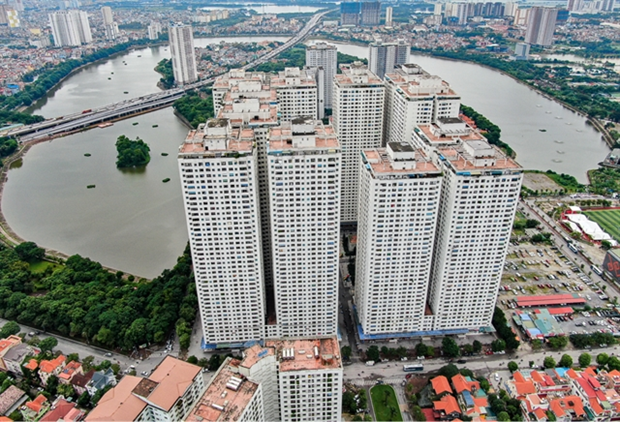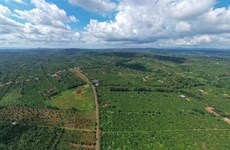Hanoi: Urban planning issues need to be solved
Over the years, violations related to the management and implementation of urban planning in Hanoi have caused many consequences, putting pressure on urban infrastructure, inner-city traffic and people's lives.
 Linh Dam HH project in Hoang Liet ward includes 12 apartment buildings of 35-40 floors each, but the public infrastructure is not commensurate with its size (Photo: VNA)
Linh Dam HH project in Hoang Liet ward includes 12 apartment buildings of 35-40 floors each, but the public infrastructure is not commensurate with its size (Photo: VNA)Facing this situation, the municipal Party Committee has recently made strong moves by issuing Directive No. 14-CT/TU requiring agencies and units to effectively implement measures to solve such issues.
Hoang Mai is an inner-city district located at the gateway to the southeast of Hanoi, covering 41 square kilometres.
The district has the most rapid urbanisation with a series of urban residential areas. However, the rapid development is causing difficulties in urban planning management.
Do Thanh Tung, deputy chairman of the district People’s Committee, said that despite detailed plans in the district, investors had not built a technical and social infrastructure system such as schools, parks, and parking lots but only focused on building houses and apartments to sell.
Phap Van – Tu Hiep residential project is another example.
Covering 50ha, the project's construction was started in late 2002 with the design of 20 apartment buildings, 100 villas, office buildings, parks, flower gardens, entertainment areas, supermarkets, schools, kindergartens and hospitals.
But investors have still not yet built any schools as per the approved plan, said Tung.
In addition, technical infrastructure was not synchronously built in some urban areas.
“Many violations of urban planning put pressure on the social and technical infrastructure of the district. Typically, the Linh Dam HH project in Hoang Liet ward was not built in accordance with the approved planning, so it leads to an increase in the population and traffic jams,” Tung said.
Similarly, in some urban residential areas in Xuan Tao and Co Nhue wards in Bac Tu Liem district, investors had not yet completed the infrastructure system after many years.
Many investors only focused on exploiting vacant land, while adjacent old residential areas and areas of which land clearance is difficult were not invested in according to the planning, said Ngo Ngoc Van, vice chairman of Bac Tu Liem district.
Head of urban management department of Thanh Tri district Trieu Dinh Hiep said that in the district, there are 11 new urban areas and housing project covering 200ha that was approved with detailed planning.
However, these projects were slow in progress, especially the Cau Buou Project that had been implemented for nearly 20 years but has not been completed yet, causing local frustration, said Hiep.
Additionally, major roads such as Ngoc Hoi and Phan Trong Tue did not have urban designs on either side of the roads, which caused difficulties for the management of landscape architecture, Hiep added.
The management of construction planning and landscape architecture is one of the strategic issues of development and a key stage in forming the face of the city today and in the future.
It is also a key management activity of local authorities to ensure stable and sustainable urban development, creating a favourable living environment for urban residents.
Directive No. 14-CT/TU demonstrates the guidance of the Hanoi Party's Committee to solve the shortcomings and limitations in urban planning and management activities.
Accordingly, the committee requested to review and strengthen the organisational apparatus for planning management and improve management staff's capacity.
At the same time, more attention must be paid to the management of planning and landscape architecture associated with each specific project, ensuring strict adherence to the original planning goals.
Hiep said: “The personal responsibilities and accountability should be accompanied by strong decentralisation to the district level to carry out procedures such as approving, appraising funds and setting regulations on construction to the projects used district budget.”
“At the same time, the city needs to organise training on planning and landscape architecture management methods suitable to each locality's reality.”
The Hanoi Planning and Architecture Department will cooperate with relevant offices to review and remove difficulties arising in architectural planning, according to Nguyen Truc Anh, the department’s director.
The department will continue to implement the project of overall construction planning of Hanoi to 2030 and complete the urban subdivision plans for the Red River and Duong River.
The director said that the formulation, appraisal and approval of planning projects would be carried out thoroughly, ensuring compliance with the law and requirements for quality, feasibility and sustainability to minimise planning adjustment.
He added that the city’s planning information would be publicised and transparent to create favourable conditions for people to monitor and manage./.













